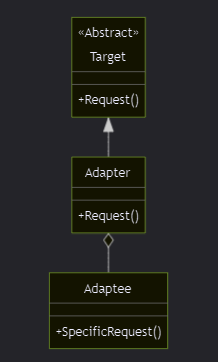适配器模式
适配器模式(Adapter Pattern)详解
定义
适配器模式是一种结构型设计模式,通过将一个类的接口转换为客户期望的另一个接口,使得原本接口不兼容的类可以一起工作。适配器模式又称“包装器(Wrapper)”。
适配器模式的结构
核心角色
- 目标接口(Target) 定义客户需要的接口,是客户代码直接调用的接口。
- 适配者(Adaptee) 现有的接口,无法直接满足客户需求。
- 适配器(Adapter) 将适配者的接口转换为目标接口,使客户可以通过目标接口访问适配者。
适配器模式的使用场景
- 旧系统的兼容性问题:当需要使用一个已有系统,但它的接口与新系统不兼容时,可以通过适配器模式进行适配。
- 第三方库整合:当使用第三方库的接口与当前项目需求不一致时,可以通过适配器封装以符合需求。
- 统一接口:在多种类似功能的接口中,适配器可以对不同实现进行封装,提供统一的访问接口。
适配器模式的优缺点
优点
- 提高兼容性:使原本不兼容的类可以协同工作。
- 遵循开闭原则:通过添加适配器实现扩展,无需修改原有代码。
- 灵活性高:可以动态添加新的适配器以支持不同的接口。
缺点
- 过多适配器增加复杂性:如果需要适配的类很多,适配器数量可能会迅速增长,导致系统复杂性提升。
- 可能影响性能:适配器的额外封装会引入一定的性能开销。
适配器模式的两种实现方式
- 类适配器(使用继承):适配器继承适配者类,并实现目标接口。
- 对象适配器(使用组合):适配器中包含适配者对象的引用,通过委托实现适配。
类适配器与对象适配器的比较
特性 | 类适配器 | 对象适配器 |
|---|---|---|
实现方式 | 使用继承 | 使用组合 |
适配者数量 | 只能适配一个类 | 可以适配多个适配者 |
灵活性 | 较低,受限于单继承 | 较高,适配器与适配者松耦合 |
扩展性 | 需要创建子类 | 不需要修改适配器类即可扩展 |
使用案例
案例 1:图形绘制系统
现有一个老版本的绘图类 LegacyRenderer,需要将其适配到新的绘图接口 NewRenderer,以兼容新功能。
案例 2:支付系统整合
整合多个第三方支付接口(如 PayPal、Stripe)到统一的支付系统中。
案例 3:硬件设备驱动
将不同厂商的硬件设备接口统一适配为系统标准接口。
适配器模式的类图

适配器模式的实现
C++ 实现
#include <iostream>
using namespace std;
// 目标接口
class Target {
public:
virtual void Request() const {
cout << "Target: Default implementation of Request" << endl;
}
virtual ~Target() = default;
};
// 适配者
class Adaptee {
public:
void SpecificRequest() const {
cout << "Adaptee: SpecificRequest called" << endl;
}
};
// 适配器
class Adapter : public Target {
private:
Adaptee* adaptee;
public:
Adapter(Adaptee* adaptee) : adaptee(adaptee) {}
void Request() const override {
adaptee->SpecificRequest();
}
};
// 客户端代码
void ClientCode(const Target* target) {
target->Request();
}
int main() {
cout << "Client: I can work just fine with the Target objects:\n";
Target* target = new Target;
ClientCode(target);
cout << "\nClient: The Adapter makes the Adaptee's interface compatible:\n";
Adaptee* adaptee = new Adaptee;
Target* adapter = new Adapter(adaptee);
ClientCode(adapter);
delete target;
delete adaptee;
delete adapter;
return 0;
}C# 实现
using System;
// 目标接口
public interface ITarget {
void Request();
}
// 适配者
public class Adaptee {
public void SpecificRequest() {
Console.WriteLine("Adaptee: SpecificRequest called");
}
}
// 适配器
public class Adapter : ITarget {
private readonly Adaptee _adaptee;
public Adapter(Adaptee adaptee) {
_adaptee = adaptee;
}
public void Request() {
_adaptee.SpecificRequest();
}
}
// 客户端代码
class Program {
static void Main(string[] args) {
Console.WriteLine("Client: I can work with Target interface:");
ITarget target = new Adapter(new Adaptee());
target.Request();
}
}适配器模式的总结
- 应用场景:适配器模式适用于系统接口不兼容,但必须协同工作的场景。
- 实现选择:类适配器在需要直接继承的情况下使用,对象适配器适用于松耦合场景。
- 灵活性:适配器可以动态适配多个不同的接口,从而提供更灵活的解决方案。
- 关键点:实现中要注意目标接口与适配者接口之间的功能映射关系,以避免错误适配。
欢迎关注、点赞、收藏!更多系列内容可以点击专栏目录订阅,感谢支持,再次祝大家祉猷并茂,顺遂无虞!
若将文章用作它处,请一定注明出处,商用请私信联系我!
本文参与 腾讯云自媒体同步曝光计划,分享自作者个人站点/博客。
原始发表:2024-12-12,如有侵权请联系 cloudcommunity@tencent.com 删除
评论
登录后参与评论
推荐阅读
目录


